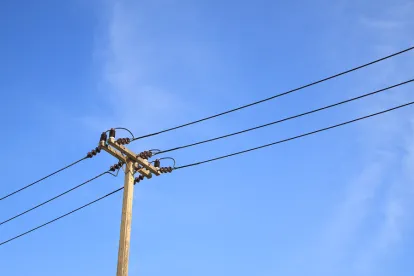On September 21, 2021, the Federal Communications Commission (FCC) issued the latest single in its anthology of decisions regulating the relationship between incumbent local exchange carriers (ILECs) and electric utilities, ensuring ILECS are charged rates comparable to similarly situated communications attachers.
In the Order in BellSouth Telecomms., LLC v. Duke Energy Progress, LLC, the FCC found that Duke Energy Progress (Duke) charged AT&T unreasonably high pole attachment rates in North and South Carolina under its existing joint use agreement compared to those competitive LECs and cable providers who attach to the same poles. Because of this unjustified inequality in rates, the FCC ordered the parties to negotiate a new agreement using the “Old Telecom Rate” to and further ordered Duke to refund to AT&T overpayments for the prior three years. Overall, the FCC’s decision was a win for AT&T and other ILECs seeking to rationalize their pole rates with competitors and to ease unjust economic burdens of pole use. That said, AT&T was unable to attain the lowest available rates under “New Telecom Rate” formula.
Key Holdings by the FCC
ILECs are similarly situated to telecommunications attachers and are therefore entitled to comparable rates.
In its 2018 Pole Attachment Order, the FCC adopted a rebuttable presumption that ILECs in new or newly-renewed agreements are “similarly situated to other telecommunications attachers” and thus subject to the FCC’s rules and orders, including “just and reasonable” rates as required by Section 224(b)(1) of the Federal Communications Act. In its AT&T v. Duke Order, the FCC found that the rates Duke charged AT&T were much higher than those Duke charged competitive LECs and cable providers to attach to the same poles. The FCC also found that the rate AT&T pays is “about 75 percent of the rate Duke pays AT&T, even though Duke’s attachments occupy much more space on the poles,” meaning that “AT&T pays far more than Duke on a per-foot basis.” This disproportionate cost allocation, along with Duke’s five-to-one pole ownership advantage, provided Duke with superior bargaining power and made negotiation for lower rates highly unlikely. After considering these factors, the FCC held that the rates Duke charged AT&T were “unjust and unreasonable,” and ordered Duke to refund to AT&T overpayments for the prior three years and to calculate future rates under the FCC rate formulas.
Under the FCC’s 2018 Pole Attachment Order, ILECs who receive benefits under a joint use agreement that materially advantage them over other attachers are not entitled lower rental rates generated under the New Telecom Rate formula.
Despite vacating the rates prescribed by the joint use agreement and requiring reimbursement, the FCC’s Order was not an unqualified win for AT&T. Instead of ordering Duke to charge AT&T according to the lower, New Telecom Rate limit as AT&T had sought, the FCC held that the higher, Old Telecom Rate formula applied.
Under the FCC’s 2018 Pole Attachment Order, an ILEC is presumed to be entitled to the New Telecom Rate for agreements entered into or renewed after March 11, 2019, unless it receives a material advantage over other telecommunications attachers on the same poles. The FCC found that the agreement provided AT&T with a number of benefits that “materially advantage AT&T over other telecommunications attachers on the same poles.” For example, AT&T had a guaranteed right to attach to any joint use poles and utilize any additional space not dedicated to other attachers. AT&T also was afforded numerous operational advantages, including a predetermined schedule of pole replacement costs, billing predictability, the lowest pole position, and no requirement to obtain prior authorization to attach to poles or to pay permitting fees. For these reasons, the FCC held that for the timeframe covered by the 2018 Pole Attachment Order, AT&T was only “entitled to a rate no greater than the Old Telecom Rate.”
For the period prior to the 2018 effective date, the FCC held that pole rates at issue are subject to the FCC’s 2011 Pole Attachment Order. Like the 2018 Pole Attachment Order, the 2011 Pole Attachment Order instructs the FCC to apply the Old Telecom Rate where an ILEC is not “similarly situated” to other attachers on the same poles. Because, the FCC found AT&T receives material advantages that are not afforded to other attachers, AT&T thus is not entitled to the New Telecom Rate under the 2011 regime either.
Termination provisions that require one-year notice effectively create a “series of one-year contracts” that automatically “renew” each year.
In reaching its decision, the FCC had to address the applicability of its 2018 Pole Attachment Order to automatically renewing (or “evergreen”) contracts like the one at issue here. As with many joint use agreements, the contract between AT&T and Duke – first effective in 2001 – would remain in force until terminated by either party, and that termination could only occur upon one year’s notice. Similar to the Commission’s analysis in Verizon Maryland LLC v. Potomac Edison, the Commission held that “the one-year notice of termination provision” in the Duke-AT&T agreement “effectively creates a series of one-year contracts that have automatically renewed and extended the [agreement] since the [agreement’s] effective date on January 1, 2001.” And because neither party issued such notice or sought termination, the FCC found the agreement automatically “renewed” each year once it became effective.
The FCC therefore held that AT&T was entitled to relief under 47 C.F.R. § 1.1413(b), which provides that the rebuttable presumption regarding rates applies to pole attachment contracts “entered into or renewed after the effective date of this section.” The Commission found that because AT&T and Duke’s joint use agreement was automatically extended on January 1, 2020 – after the March 11, 2019 effective date of the 2018 rule changes – the rates Duke charged since then were reviewable under the 2018 Pole Attachment Order. Conversely, rates charged by Duke prior to January 2020 were to be evaluated under the 2011 Pole Attachment Order.
Related Nuclear Costs should be included when assessing Gross Plant Investment.
In its Order, the FCC also clarified the appropriate inclusion of nuclear fuel and materials in gross plant investment in both the numerator and denominator when calculating the carrying charges (taxes, depreciation, maintenance, and administrative) of its pole rate formula.
The 40-Foot Pole: The “New Normal.”
The FCC rejected Duke’s argument that it could impose higher rates because it had built a network of primarily 40-foot poles in its overlapping services area to accommodate AT&T. The FCC held that competitive LECs and cable companies have increasingly required space on poles for decades, necessitating bigger and stronger poles. This recognition of the prevalence of 40-foot poles in today’s utility landscape calls into question the continued use of the 13.5-foot usable space factor (based on a 37.5-foot pole) in the FCC rate formulas instead of a larger number that better reflects taller poles.





 />i
/>i

